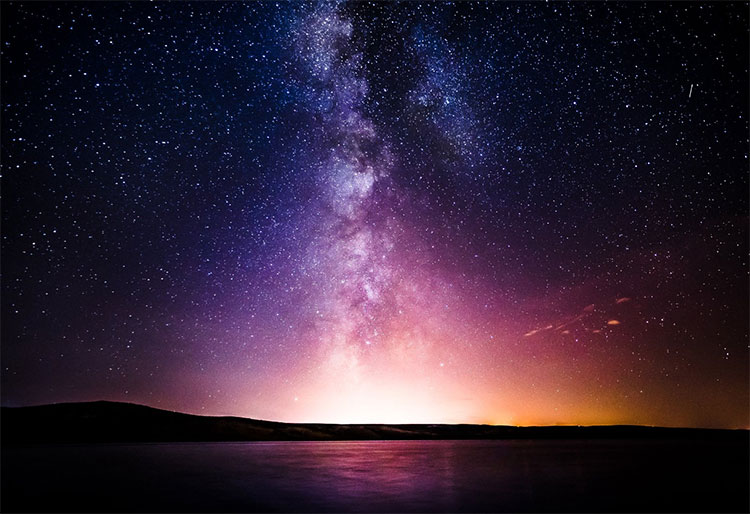Millions of black holes are hiding in our galaxy
There is a controversy raised by the Japanese space physics duo who have proposed a quest for millions of 'isolated black holes' (abbreviated IBH) to be possible. ability to live right in our galaxy.
These black holes, lost in the dark, silently suck in matter in the universe - cosmic dust and interstellar floating materials. But that process was ineffective and a large amount of material was pushed into space at great speed.
Researchers believe that when that flow affects the surrounding environment, it will produce radio waves that human radio telescopes can detect. If cosmologists can filter these waves from disturbances in the galaxy, they can detect these invisible black holes.
Researchers wrote in the report, though not yet reviewed by peer scientists and published on July 1 with a preprinted version on arXiv: 'The most original way to track IBH is their X-ray emission ".
Why so? When black holes suck matter from space, those materials accelerate at their edges and form what is called an accretion disk . The matter in this accretion disk rubbed itself and turned toward the horizon, the event - the irreversible point of a black hole - emitting X-rays in the process.

The time has come for us to find black holes that are still hiding.
But black holes are isolated, with sizes much smaller than super black holes, not emitting large amounts of X-rays in this way. Simply put, there is not enough material or energy in its accretion disk to produce a large X-ray signal. Past X-ray searches for IBH have failed and no conclusive conclusions have been reached.
Two researchers Daichi Tsuna of Tokyo University and Norita Kawanaka of Kyoto University wrote in their study the following 'Flows that make IBH can be detected by other wavelengths. Flows can interact with surrounding materials and create strong non-collision vibrations on the sides. These vibrations can amplify magnetic fields and accelerate electrons, which then emit electromagnetic radiation in radio waves'.
In other words, these currents will slip through cosmic matter if it causes electrons to travel at speeds that can produce radio waves.
Simon Protegies Zwart, cosmological physicist at Leiden University, the Netherlands, who was not involved in Tsuna's research and Kawanaka, said it was an interesting study. Protegies Zwart also studies the mysteries of IBH, also known as medium mass black hole (Intermediate mass black hole - abbreviated as IMBH).
Protegies Zwart said: 'It will be a good way to find IMBH. I think that with LOFAR (low-frequency array in the Netherlands), these studies will probably be realized but the level of reception may cause some problems'.
The IBHs, explained Protegies Zwart, are considered a 'missing link' between the two types of black holes that cosmologists can detect: black holes of star masses that are twice or 100 times the size solar size, and supermassive Black Hole , a giant animal that lives in the center of galaxies that is hundreds of thousands of times more massive than our sun.
Stellar black holes can sometimes be detected in binary systems with normal stars, because binary systems can generate gravitational waves and companion stars can provide fuel for Large X-ray bursts. Super mass black holes with accretion disks spread so much energy that astronomers can detect and even photograph them.
But IBH, in the middle of the other two categories, is harder to detect. There are many objects in the space that astronomers suspect may be IBH, but those results are uncertain. But according to previous research, including the 2017 article in the monthly journal of the Royal Astronomical Society, which Portegies Zwart co-authored, shows that millions of IBH may be hiding out in space.
Tsuna and Kawanaka have announced the best prospect for a radio survey on IBH may involve the use of SKA telescopes, a radio telescope that is partly due to the cluster installation in South Africa and Australia. It is expected to have about 1km 2 of radio waves. The researchers calculated that at least 30 outflows of IBH waves would be detected by the SKA during the first attempt to prove the concept was scheduled for 2020. In conclusion, they wrote, with complete SKA (expected in mid 2020). will be able to scan up to 700km 2 .
Not only can the SKA receive radio waves from these IBHs, it can also accurately calculate the distance to these black holes. Until then, these hidden black holes will begin to be brought to light.
- Black holes are also
- The galaxy has 3 black holes
- Discover the mystery of the most exotic black holes in the universe
- 26 new black holes in Tien Nu galaxy
- Rare discovery of twin black superholes
- Face hiding 'monster' black hole
- Stunned black hole goods 'terrible' in two small galaxies
- For the first time, two black holes revolved around each other
- Detecting black holes 'monsters' 350 million times more massive than the Sun.
- Black hole woke up after 30 years,
- Decoding mistakenly thought that the black hole of the universe is
- The largest black holes in the universe
 Van Allen's belt and evidence that the Apollo 11 mission to the Moon was myth
Van Allen's belt and evidence that the Apollo 11 mission to the Moon was myth The levels of civilization in the universe (Kardashev scale)
The levels of civilization in the universe (Kardashev scale) Today Mars, the sun and the Earth are aligned
Today Mars, the sun and the Earth are aligned The Amazon owner announced a secret plan to build a space base for thousands of people
The Amazon owner announced a secret plan to build a space base for thousands of people